Printer Properties (Windows 98/Me) - Page Setup Tab-IC D300 Series
| Article ID: ART125837 | | | Date published: 05/12/2015 | | | Date last updated: 08/14/2015 |
Description
Solution
Printer Properties (Windows 98/Me) - Page Setup Tab
Edit Watermark
Custom Paper Size...
Layout Options
Profiles
Add Profiles
Edit Profiles
View Settings
Specifies the paper settings including the paper size, scaling, number of copies, orientation and number of pages per sheet.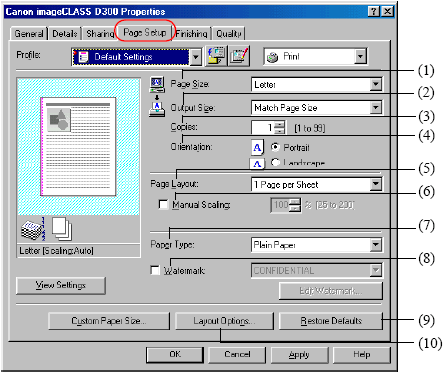
Default settings depend on the country/region of purchase.
| (1) | Page Size lets you select the paper size you are working with in your application. Available options are A4, B5, A5, Letter, Legal, Executive, Envelope#10,and Envelope Monarch. For Windows 98/Me operating system, free size paper is also available. Up to 50 types of free size paper can be defined with the [Custom Paper Size] options. | |
| (2) | Output Size lets you select the paper size to print on. If your output size is set to anything other than [Match Page Size], the image will automatically be reduced or enlarged to fit on the page. | |
| (3) | Copies lets you specify the number of copies to be printed (1 to 99). | |
| (4) | Orientation lets you select the direction of printing relative to the paper (Portrait or Landscape). | |
| (5) | Page Layout lets you select the number of pages per sheet (1, 2, 4, 8, 9, 16) and [Poster] (2x2, 3x3, 4x4 pages to comprise one sheet). If you select an option other than [1 Page per Sheet] and [Poster], the image may be reduced to fit on the selected output size and [Manual Scaling] (6) disappears and [Page Order] (11) appears in its place. When [Poster] is selected, [Manual Scaling] (6), [Watermark] (8) and [Layout Options] (10) are disabled. | |
| (6) | Manual Scaling lets you shrink or enlarge images. This option only appears when [1 Page per Sheet] is selected as the [Page Layout] (5). Checking this check box enables the edit box on the right side to specify the magnification factor (25 to 200). |

| (11) | Page Order lets you select the order in which original pages are placed on each sheet of the output paper when more than one page is printed per sheet. | |
| (7) | Paper Type lets you select the appropriate paper type to print on from the drop-down list. Plain paper (17 to 24-lb bond or 64 to 90 g/m2 ) Transparencies Special Paper 1: (25 to 32-lb bond or 91 to 128 g/m2 ) Special Paper 2: Rough paper |
|
| (8) | Watermark lets you insert the watermark to be printed on the document. Eight types of watermark are available as default. This option is disabled when [Page Layout] (5) is set to [Poster]. Checking this checkbox enables the [Edit Watermark] option. | |
| (9) | Restore Defaults resets all the current settings to their default values. | |
| (10) | Layout Options opens the [Layout Options] dialog box. |
 Edit Watermark
Edit Watermark
Click [Edit Watermark] in the [Page Setup] tab window opens the [Edit Watermark] dialog box. This dialog box allows you to insert a text string as a watermark onto pages. This option is enabled only when the [Watermark] checkbox is checked in the [Page Setup] tab window.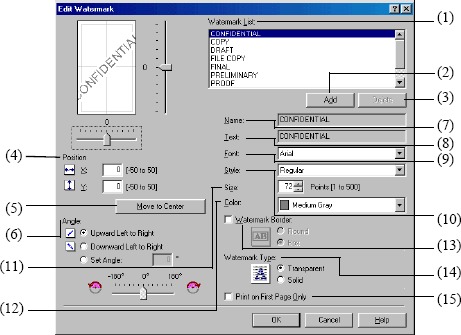
| (1) | Watermark List displays the names of registered watermarks. The preview image in the upper left part of the dialog box displays the selected watermark with the specified settings reflected. | |
| (2) | Add lets you register a new watermark. Clicking this button adds a blank name field in [Watermark List] (1) in which you enter the name of watermark to be registered. Up to 50 watermarks can be registered. | |
| (3) | Delete removes the selected watermark from [Watermark List] (1). | |
| (4) | Position lets you set the position where the watermark is printed on each page. To set the position, specify the values in the [X] and [Y] edit boxes (in a range between -50 and +50), or use the [X] and [Y] slide bars. | |
| (5) | Move to Center relocates the watermark to the page center. | |
| (6) | Angle lets you set the angle of watermark. To set the angle, select the corresponding radio button, or use the slide bar. | |
| (7) | Name displays the name of the currently selected watermark. | |
| (8) | Text displays the text string of the currently selected watermark. | |
| (9) | Font lets you select the font type of the text watermark from the drop-down list. | |
| (10) | Style lets you select the font style of the text watermark from the drop-down list. Available styles are [Regular], [Italic], [Bold], and [Bold Italic]. | |
| (11) | Size lets you specify the font size of the text watermark. | |
| (12) | Color lets you select the font color of the text watermark from the drop-down list. | |
| (13) | Watermark Border lets you select either of [Round] or [Box] for the frame type of the watermark. | |
| (14) | Watermark Type lets you select either of [Transparent] or [Solid] for the watermark type. | |
| (15) | Print on First Page Only lets you select whether the watermark appears only on the first page or all pages. |
 Custom Paper Size Settings
Custom Paper Size Settings
Clicking [Custom Paper Size...] in the [Page Setup] tab window opens the [Custom Paper Size Settings] dialog box. This dialog box allows you to define custom paper sizes for quick selection and register new custom paper sizes to the [Paper List](1) box. You can specify the name, width, and height of each size. Up to 50 custom sizes can be defined.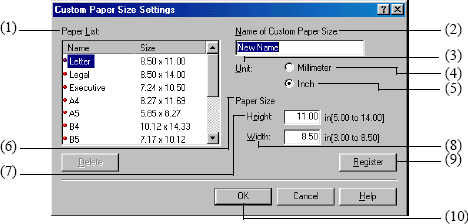
Selecting a Custom Paper Size
- Select one of the predefined sizes from the [Paper List] (1) box.
- If you wish, enter a unique name in the [Name of Custom Paper Size] (2) area.
- Select the Millimeter (4) or Inch (5) for Unit (3) of measurement.
-
Define the [Paper Size] (6) using the [Height] (7) (5.00 to 14.00 inches/127.0 to 356 mm) and [Width] (8) (3.00 to 8.50 inches/76.2 to 216 mm) settings.

Be sure to specify values such that [Height] (7) is equal to or greater than [Width] (8).
- Click [Register] (9) to accept your changes, then click [OK] (10).
If you wish to restore the default settings to all of the custom sizes, click [Restore Defaults].
top
 Layout Options
Layout Options
Clicking [Layout Options] in the [Page Setup] tab window opens the [Layout Options] dialog box. This dialog box allows you to print pages with a page frame, header, and footer. This option is disabled when [Page Layout] in the [Page Setup] tab window is set to [Poster].
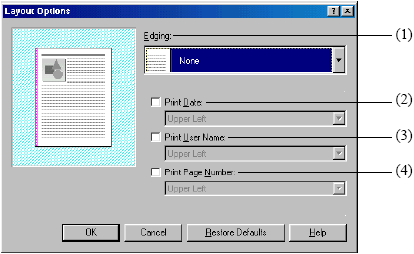
| (1) | Edging lets you add a page frame to be printed on each page. 11 options are available. [Edging] is not available to use with [Print Sample] in the [Quality] tab. | |
| (2) | Print Date lets you add the date to be printed on each page. Six positions to print the date are available. | |
| (3) | Print User Name lets you add the user name to be printed on each page. Six positions to print the user name are available. | |
| (4) | Print Page Number lets you add the page number to be printed on each page. Six positions to print the page number are available. |
 Profiles
Profiles
A registered combination of settings for the [Page Setup] (1), [Finishing] (2) and [Quality] (3) tab windows is referred to as a profile. The profile function commonly provided in each of these tab windows allows you to add, edit, and select a profile, which facilitates your print jobs.
| (4) | Profile lets you select one of the registered profiles from the drop-down list. The preview image (5) under the drop-down list displays the image with the currently selected settings reflected. Right-clicking the mouse button on the preview image displays the pop-up menu, from which you can change the setting for [Page Layout] and open the [Edit Watermark/Layout Options] dialog box. |
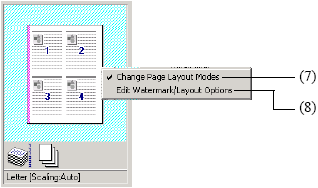
| (7) | Change Page Layout Modes lets you change the setting for [Page Layout]. The setting changes in the following order; [1 Page per Sheet], [2 Pages per Sheet], [4 Pages per Sheet], [1 Page per Sheet]. | |
| (8) | Edit Watermark/Layout Options opens the [Layout Option] dialog box when the frame of the image is clicked, and the [Edit Watermark] dialog box when anywhere inside the image is clicked. | |
| (6) | The job mode drop-down list allows you to switch the job mode between [Print] and [Edit and Preview]. The [Print] mode executes a normal print job. The [Edit and Preview] mode saves the data in the Canon Page Composer dialog box. When the [Edit and Preview] mode is selected, |
Add Profiles
Clicking  (Add) opens the [Add Profile] dialog box. This dialog box allows you to register a new profile with the current settings.
(Add) opens the [Add Profile] dialog box. This dialog box allows you to register a new profile with the current settings.
| (1) | Name lets you specify the name of the profile to be registered. | |
| (2) | Icon lets you select an icon to represent the profile to be registered. | |
| (3) | Comment lets you add comments on the profile to be registered. |
Edit Profiles
Clicking  (Edit) opens the [Edit Profile] dialog box. This dialog box allows you to edit the profile selected in [Profile List].
(Edit) opens the [Edit Profile] dialog box. This dialog box allows you to edit the profile selected in [Profile List].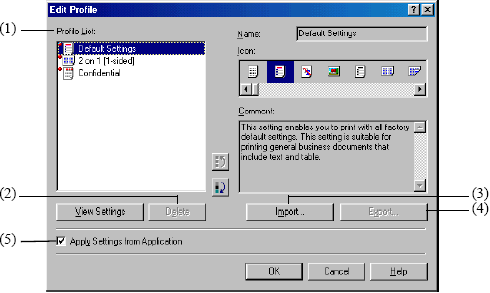
| (1) | Profile List displays the list of registered profiles. The order that the profiles appear in this list is the order they appear in the [Profile] pull-down list in the [Page Setup], [Finishing], and [Quality] tab windows. | |
| (2) | Delete deletes the profile selected in [Profile List] (1). When any of the pre-defined profiles is selected, this button is disabled. | |
| (3) | Import allows you to import profile information from a file. | |
| (4) | Export allows you to export the selected profile information to a file. | |
| (5) | Apply Settings from Application applies the selected profile only to the settings other than [Paper Size], [Orientation] and [Copies]. |
View Settings
Clicking [View Settings] opens the [View Settings] dialog box. This dialog box displays the current settings in the [Page Setup], [Finishing], and [Quality] tab windows.
back
